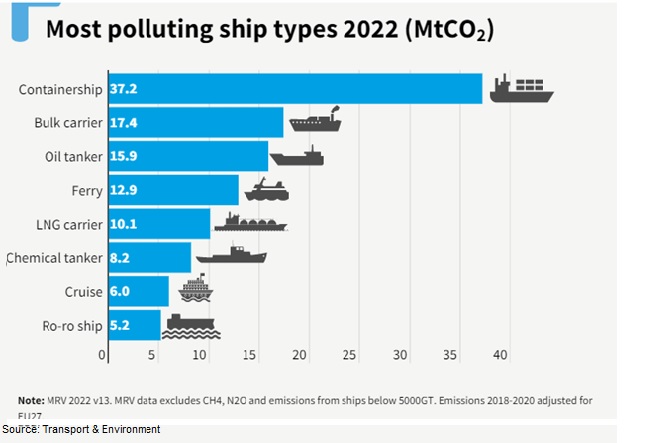-
Container and cargo ships make up the lion’s share of shipping emissions in Europe that reached a three-year high last year
-
But Transport & Environment green campaign group says LNG-carriers and cruise ships were the main driver of increased emissions in 2022
-
T&E says without stricter regulations, shipping firms will continue to spurn investment in efficiency and green fuels, moving the industry quickly to a point of no return
Europe’s shipping CO2 emissions rose 3% to a three-year high in 2022 as the industry edged closer to its pre-pandemic level of activity, with container and other cargo ships making up the lion’s share of vessel emissions, an analysis by Transport & Environment (T&E) shows.
T&E said ships visiting European ports in 2022 emitted nearly 130 million tons of carbon dioxide (CO2). A revival in leisure travel also increased cruise ship emissions from the 2021 levels to 6 million tons last year, the report said.
The major cargo shipping trend in 2022 was the increased volume of LNG shipments, which grew 58%. As Europe ramped up sanctions on Russian oil, European import push for LNG drove a massive increase in seaborne emissions, said T&E, the continent’s leading clean transport campaign group.
“Carbon emissions are at a three-year high as shipping companies continue to go all guns blazing. Europe’s shipping giants are up there with coal plants and airlines as the continent’s biggest polluters,” said Jacob Armstrong, shipping manager at T&E.
MSC, the world’s largest ocean liner firm, got the most blame as Europe’s shipping CO2 emissions rose. The Switzerland-based giant pumped out 10.2 million tons of CO2 last year, making it Europe’s 11th biggest polluter across all industries that inclided coal plants and airlines, T&E said.
MSC was followed by France’s CMA CGM at 5.5 million tons of CO2 emission, Denmark’s Maersk at 5.2 million tons, China’s COSCO at 3.8 million tons and Germany’s Hapag-Lloyd at 3.3 million tons on the list of shipping emitters. Of the top five air polluters, the only non-European operator was COSCO.
“Without stricter regulations, shipping companies will continue to spurn investments in efficiency and green fuels. The industry is quickly moving to a point of no return,” Armstrong said.
Maersk and CMA CGM as well as other leading ocean container carriers have already ordered dozens of green methanol-fueled vessels to join their fleets from early 2024 onward. COSCO’s unit OOCL has already ordered dual-fuel methanol ships while Korean ocean liner HMM has nine methanol-fueled container vessels being built by two shipyards in South Korea.
The analysis said cruise ship emissions in 2022 nearly doubled from their 2021 levels after a year of disruptions to international travel. The most polluting ship last year was the MSC Grandiosa, which was solely responsible for over 130,000 tons of CO2 – the same as a small town’s emission.
Inadequate electrification at ports are partly to blame for the increased shipping emissions, according to the T&E report. It said carbon pollution – along with sulphur oxide (SOx), nitrogen oxide (NOx) and suspended particulate matter (PM 2.5) at ports increased slightly in 2022. This could be fixed easily by greater shore-side electrification, the report said.
“Without stricter regulations, shipping companies will continue to spurn investments in efficiency and green fuels. We will continue to monitor European shipping emissions to make sure shipping companies are held to account,” T&E said.





